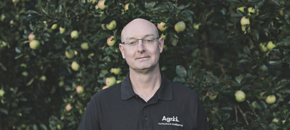
Talking Agronomy | Greg Taylor - September 2021
Blog - 07.09.21
Another catchy harvest, and wheat yields have been decidedly mixed so far. On the plus side, though, a week of unsettled weather before most of our wheat came ready was just what we needed to drill most of our oilseed rape and make a determined start on catch and cover crops.
With both warmth and moisture, the OSR and its companions are coming through fast as we go into the second half of August, giving the crop plenty of time to get ahead of any flea beetle migration. Most of our forage covers for livestock grazing also look promising.
Our twin priorities now are bringing-in the wheat and spring barley before either get too ‘weathered’ while getting-in the rest of our catch and cover crops before it gets too late.
Even on heavy soils – where we find direct drilling can work just as well as on lighter ground with the sort of care and attention, I give my old ‘pride and joy’ Jag – autumn decisions are relatively simple for those well down the no-till road.
The key question for the majority, though, is how much emphasis to put on covers against cultivations? To which, I’m afraid, there is no easy answer.
On the one hand, we want to cut tillage and build soil health. But on the other, we can’t afford to let grassweeds off the hook by failing to flush out enough of them ahead of our next crop.
Although decent winter covers are good at out-competing weeds that emerge, we find they do nothing to deplete the seed bank, leaving a dangerous legacy to emerge in following crops. They can also play havoc with the meadow and soft bromes that require a period of ripening on the surface to break dormancy.
Our decisions this season are not being made any easier by the extent to which blackgrass has taken advantage of the wet winter and cold, late spring in many cases. Nor by soil problems from cereal drilling in difficult conditions last winter.
Although as little as possible is our watchword with tillage, we also do as much as necessary, with drainage our key consideration.
We know, from bitter wet season experience, that moving to no till before getting the drainage right is a recipe for disaster. So, wherever our ‘spadework’ uncovers problems, we are tackling them with low disturbance tines and minimal soil movement at the surface, combining this with cover crop establishment wherever we can. That way we can remedy compaction, aid drainage and aerate the soil with the least possible disruption to flora, fauna and carbon.
More than anything else, we are looking to rotations to aid our tillage transition. Several seasons of competitive spring crops following competitive covers have really helped our grassweed control. And those established later in the spring are invariably cleaner with a better soil structure too.
It may not be the most competitive crop but late-sown spring linseed has been a great grassweed cleaner for us. It has also been very good for soil structuring. And its stubble gives us a valuable direct drilling entry for wheat.
However we do it – whether by extending the rotation, cover and spring cropping or well-planned autumn cultivation – we are firmly focused on farming grassweeds out of the system as we transition. For which we are working to clear plans with the aim of reducing the need for delayed drilling.
Alongside drainage, improving soil organic matter is, of course, another key here. But one that the latest Farming Rules for Water really get in the way of. How can it be better to spread manures on wet, vulnerable ground in the spring rather than on those most receptive and least susceptible after harvest?
If the Powers-that-Be really want us to improve soil health, surely it is not too much to ask that they see the value of applying low readily-available N manures in the autumn?
Greg Taylor
Join Our Community

Agrii X
We love engaging with clients and partners. Give us a follow and let's share stories for the community.

Agrii Instagram
A picture paints a thousand words. Follow us on Instagram to see what we are up to.

Agrii Facebook
Follow us on the worlds biggest social media site for the latest news and events straight to your feed.

Agrii LinkedIn
If you are all about the business, connect with us on LinkedIn to build your network
Stay In Touch

Newsletter Sign-Up
Receive email updates on topical news and information from around Agrii and UK Farming.

Listen To Our Podcasts
Listen to the Tramlines Podcast. Fortnightly chat about agriculture and trials with your host Tony Smith.

Agrii Insights
Read essential agri intelligence for profitable farming.

Find an Event
Join us for our upcoming events and tours.



